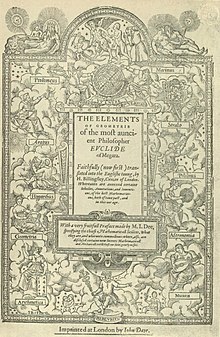എലിമെന്റ്സ്
ഈജിപ്തിലെ അലക്സാണ്ട്രിയയിൽ ജീവിച്ചിരുന്ന ഗ്രീക്ക് ഗണിതശാസ്ത്രജ്ഞനായിരുന്ന യൂക്ലിഡ് രചിച്ച പതിമൂന്ന് പുസ്തകങ്ങളടങ്ങിയ ഗണിതശാസ്ത്രഗ്രന്ഥമാണ് എലിമെന്റ്സ് (പുരാതന ഗ്രീക്ക്: Στοιχεῖα Stoicheia). ക്രിസ്തുവിന് മുന്നൂറു വർഷം മുമ്പ് രചിക്കപ്പെട്ട ഈ ഗ്രന്ഥത്തിൽ ഗണിതത്തിലെ നിർവചനങ്ങളും പ്രമേയങ്ങളും ജ്യാമിതീയസൃഷ്ടികളും അവയുടെ തെളിവുകളും അടങ്ങിയിരിക്കുന്നു. ദ്വിമാനവും ത്രിമാനവുമായ യൂക്ലിഡീയൻ ജ്യാമിതി, പ്രാഥമിക സംഖ്യാസിദ്ധാന്തം, സാനുപാതമല്ലാത്ത രേഖാഖണ്ഡങ്ങൾ എന്നിവയാണ് എലിമെന്റ്സിലെ പ്രതിപാദ്യവിഷയം. യുക്തി, ആധുനിക ശാസ്ത്രം എന്നിവയുടെ വികസനത്തിൽ ഈ ഗ്രന്ഥം പ്രധാന പങ്കു വഹിച്ചു.
 സർ ഹെൻറി ബില്ലിങ്സ്ലിയുടെ എലിമെന്റ്സിന്റെ ആദ്യ ഇംഗ്ലിഷ് പതിപ്പ് (1570) | |
| കർത്താവ് | യൂക്ലിഡ് |
|---|---|
| ഭാഷ | പുരാതന ഗ്രീക്ക് |
| വിഷയം | യൂക്ലിഡിയൻ ജ്യാമിതി, പ്രാഥമിക സംഖ്യാസിദ്ധാന്തം, സാനുപാതമല്ലാത്ത രേഖകൾ |
| സാഹിത്യവിഭാഗം | ഗണിതം |
പ്രസിദ്ധീകരിച്ച തിയതി | c. 300 BC |
| ഏടുകൾ | 13 പുസ്തകങ്ങൾ |
ചരിത്രത്തിലെ ഏറ്റവും വിജയകരവും[1][2] സ്വാധീനമുള്ളതുമായ[3] പാഠപുസ്തകമായി എലിമെന്റ്സ് കരുതപ്പെടുന്നു. അച്ചടിവിദ്യയുടെ കണ്ടുപിടിത്തത്തിനു ശേഷം ആദ്യമായി അച്ചടിക്കപ്പെട്ട ഗ്രന്ഥങ്ങളിലൊന്നായ എലിമെന്റ്സ് ബൈബിളിനു ശേഷം ഏറ്റവുമധികം പതിപ്പുകൾ ഇറങ്ങിയ ഗ്രന്ഥവുമാണ്.[3] 1482 നു ശേഷം ആയിരത്തിലധികം പതിപ്പുകൾ ഇങ്ങനെ ഇറങ്ങിയിട്ടുണ്ട്..[4] നൂറ്റാണ്ടുകളോളം എല്ലാ സർവ്വകലാശാലകളിലെ വിദ്യാർത്ഥികളും എലിമെന്റ്സ് ഭാഗികമായെങ്കിലും അവരുടെ പാഠ്യപദ്ധതിയുടെ ഭാഗമായി വായിക്കേണ്ടിയിരുന്നു. ഇരുപതാം നൂറ്റാണ്ടിൽ എലിമെന്റ്സിലെ ഉള്ളടക്കം മറ്റു പാഠപുസ്തകങ്ങളുടെ ഭാഗമായി പഠിപ്പിക്കാൻ തുടങ്ങിയതോടെ മാത്രമാണ് "വിദ്യാസമ്പന്നരായ എല്ലാവരും വായിച്ചിരുന്നിട്ടുണ്ടാകുമായിരുന്ന പുസ്തകം" എന്ന വിശേഷണം ഈ ഗ്രന്ഥത്തിന് നഷ്ടപ്പെട്ടത്.[5]
അവലംബം
തിരുത്തുക- ↑ Encyclopedia of Ancient Greece (2006) by Nigel Guy Wilson, page 278. Published by Routledge Taylor and Francis Group. Quote:"Euclid's Elements subsequently became the basis of all mathematical education, not only in the Roman and Byzantine periods, but right down to the mid-20th century, and it could be argued that it is the most successful textbook ever written."
- ↑ Boyer (1991). "Euclid of Alexandria". p. 100.
As teachers at the school he called a band of leading scholars, among whom was the author of the most fabulously successful mathematics textbook ever written – the Elements (Stoichia) of Euclid.
{{cite book}}: Missing or empty|title=(help) - ↑ 3.0 3.1 Boyer (1991). "Euclid of Alexandria". p. 119.
The Elements of Euclid not only was the earliest major Greek mathematical work to come down to us, but also the most influential textbook of all times. [...]The first printed versions of the Elements appeared at Venice in 1482, one of the very earliest of mathematical books to be set in type; it has been estimated that since then at least a thousand editions have been published. Perhaps no book other than the Bible can boast so many editions, and certainly no mathematical work has had an influence comparable with that of Euclid's Elements.
{{cite book}}: Missing or empty|title=(help) - ↑ The Historical Roots of Elementary Mathematics by Lucas Nicolaas Hendrik Bunt, Phillip S. Jones, Jack D. Bedient (1988), page 142. Dover publications. Quote:"the Elements became known to Western Europe via the Arabs and the Moors. There, the Elements became the foundation of mathematical education. More than 1000 editions of the Elements are known. In all probability, it is, next to the Bible, the most widely spread book in the civilization of the Western world."
- ↑ From the introduction by Amit Hagar to Euclid and His Modern Rivals by Lewis Carroll (2009, Barnes & Noble) pg. xxviii:
Geometry emerged as an indispensable part of the standard education of the English gentleman in the eighteenth century; by the Victorian period it was also becoming an important part of the education of artisans, children at Board Schools, colonial subjects and, to a rather lesser degree, women. ... The standard textbook for this purpose was none other than Euclid's The Elements.